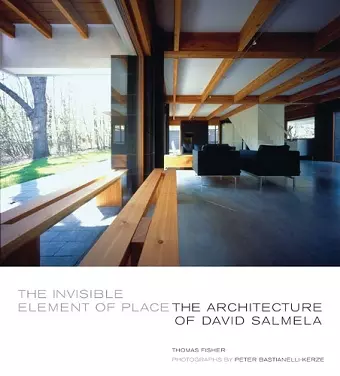The Invisible Element of Place
The Architecture of David Salmela
Format:Paperback
Publisher:University of Minnesota Press
Published:23rd May '11
Currently unavailable, and unfortunately no date known when it will be back

“Even though it’s bold, it doesn’t shout at you,” David Salmela says of the silvery house he designed for a woodsy setting in Deephaven, Minnesota. “It’s not a barking dog. It’s a resting, very gentle animal.” The American Institute of Architects, conferring its 2008 Housing Award, was more direct: the house was, in the words of the jury, “brilliantly designed.” The Streeter house is just one of fifty-one notable projects by Minnesota architect Salmela featured in The Invisible Element of Place.
Thomas Fisher explores both the beauty and the practicality of Salmela’s award-winning designs—and offers insight into how an architectural firm as small and remote as Salmela’s has been able to produce such consistently remarkable and internationally recognized results. Profiling such building projects as Jackson Meadow, a conservation community that has become a nationwide model; the Hawks Boot Factory, Zamzow house, and Bagley Nature Pavilion, which emphasize green building, solar power, and the use of natural light; and the Chrismer, Koch, Fiore, Roland, Ramberg, and Grams cabins, meshing clients’ particular needs and the land’s peculiar constraints, this book provides a rare vision of architectural design.
Gorgeous images from one of the nation’s most unique architectural photographers showcase how Salmela’s designs work in concert with individual wishes, environmental concerns, and artistic understanding, and his breathtaking buildings reflect the Midwest’s culture, history, and, ideally, its future.
"For anyone who’s ever marveled at the purity and austerity of homes designed by David Salmela, The Invisible Element of Place provides a fascinating look at the work of one of Minnesota’s premier architects." —Minneapolis-St. Paul Magazine
"A wonderful coffee-table book for anyone who appreciates architecture—especially Salmela’s mastery of Midwestern vernacular." —Midwest Home
"The book creates a rich experience for the reader, evoking the close connections between residential architecture and other, seemingly unrelated disciplines. Architect readers will enjoy it for the poetry of Salmela’s buildings as well as the author’s intellectually omnivorous approach to covering them." —Residential Architect
ISBN: 9780816669943
Dimensions: 267mm x 241mm x 18mm
Weight: unknown
272 pages